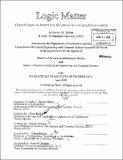| dc.contributor.advisor | Terry Knight and Patrick W inston. | en_US |
| dc.contributor.author | Tibbits, Skylar J. E | en_US |
| dc.contributor.other | Massachusetts Institute of Technology. Dept. of Electrical Engineering and Computer Science. | en_US |
| dc.date.accessioned | 2011-06-20T15:52:11Z | |
| dc.date.available | 2011-06-20T15:52:11Z | |
| dc.date.copyright | 2010 | en_US |
| dc.date.issued | 2010 | en_US |
| dc.identifier.uri | http://hdl.handle.net/1721.1/64566 | |
| dc.description | Thesis (S.M.)--Massachusetts Institute of Technology, Dept. of Architecture; and, (S.M.)--Massachusetts Institute of Technology, Dept. of Electrical Engineering and Computer Science, 2010. | en_US |
| dc.description | Cataloged from PDF version of thesis. | en_US |
| dc.description | Includes bibliographical references (p. 123-124). | en_US |
| dc.description.abstract | Given the increasing complexity of the physical structures surrounding our everyday environment -- buildings, machines, computers and almost every other physical object that humans interact with -- the processes of assembling these complex structures are inevitably caught in a battle of time, complexity and human/machine processing power. If we are to keep up with this exponential growth in construction complexity we need to develop automated assembly logic embedded within our material parts to aid in construction. In this thesis I introduce Logic Matter as a system of passive mechanical digital logic modules for self-guided-assembly of large-scale structures. As opposed to current systems in self-reconfigurable robotics, Logic Matter introduces scalability, robustness, redundancy and local heuristics to achieve passive assembly. I propose a mechanical module that implements digital NAND logic as an effective tool for encoding local and global assembly sequences. I then show a physical prototype that successfully demonstrates the described mechanics, encoded information and passive self-guided-assembly. Finally, I show exciting potentials of Logic Matter as a new system of computing with applications in space/volume filling, surface construction, and 3D circuit assembly. | en_US |
| dc.description.statementofresponsibility | by Skylar J.E. Tibbits. | en_US |
| dc.format.extent | 126 p. | en_US |
| dc.language.iso | eng | en_US |
| dc.publisher | Massachusetts Institute of Technology | en_US |
| dc.rights | M.I.T. theses are protected by
copyright. They may be viewed from this source for any purpose, but
reproduction or distribution in any format is prohibited without written
permission. See provided URL for inquiries about permission. | en_US |
| dc.rights.uri | http://dspace.mit.edu/handle/1721.1/7582 | en_US |
| dc.subject | Architecture. | en_US |
| dc.subject | Electrical Engineering and Computer Science. | en_US |
| dc.title | Logic matter : digital logic as heuristics for physical self-guided-assembly | en_US |
| dc.type | Thesis | en_US |
| dc.description.degree | S.M. | en_US |
| dc.contributor.department | Massachusetts Institute of Technology. Department of Architecture | |
| dc.contributor.department | Massachusetts Institute of Technology. Department of Electrical Engineering and Computer Science | |
| dc.identifier.oclc | 726748084 | en_US |
